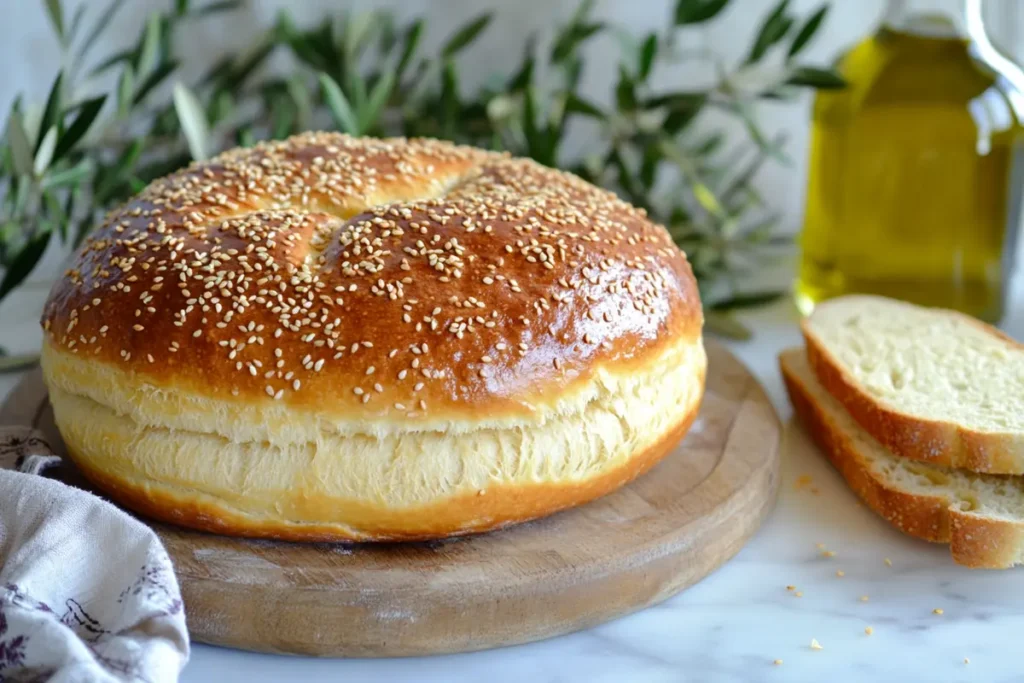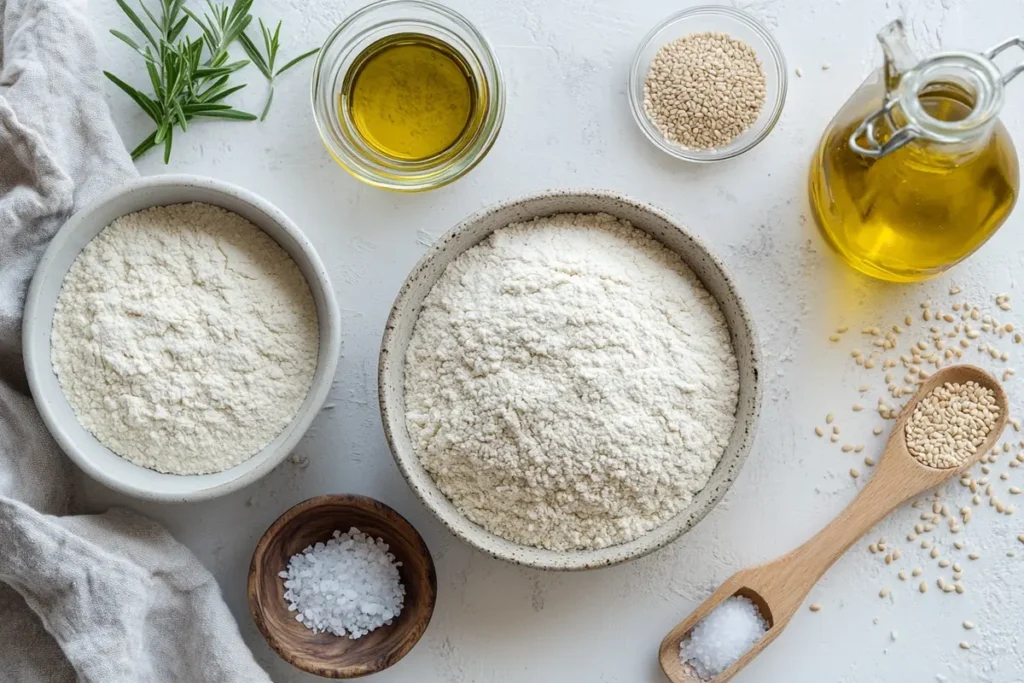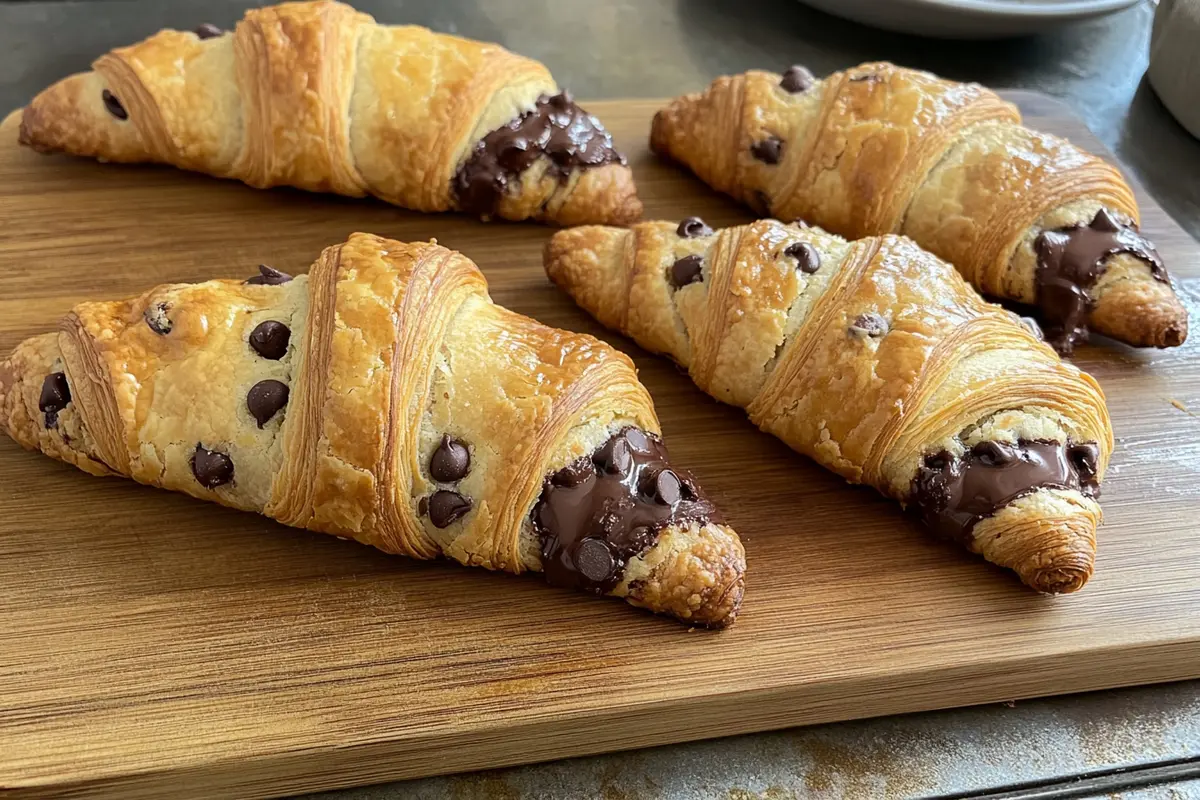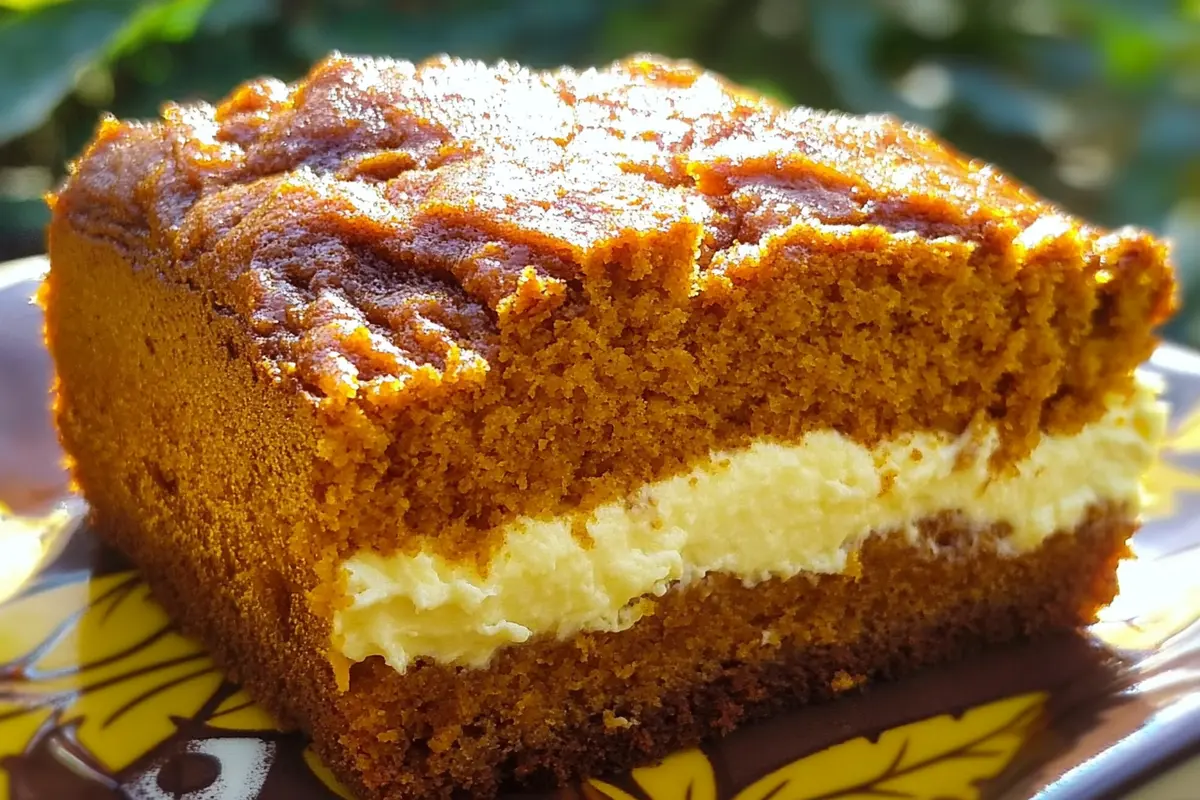An iconic bread with roots tracing back to Sicilian culture, muffuletta bread is more than just a baking delight; it’s a culinary symbol cherished in New Orleans and beyond. In this article, we’ll explore its fascinating history, uncover the secrets of its texture and flavor, and guide you through making and using this bread in creative ways. Get ready to dive into the rich heritage and modern versatility of muffuletta bread!
Introduction to Muffuletta Bread
Muffuletta Bread: A Culinary Icon
Muffuletta bread holds a revered place in both Sicilian and New Orleans cuisine. Its round shape, golden crust topped with sesame seeds, and soft, airy interior make it unique and perfect for hearty sandwiches or standalone enjoyment. For many, this bread is synonymous with the muffuletta sandwich, but its significance runs much deeper than that iconic dish. Whether you’re a foodie or a baking enthusiast, understanding muffuletta bread connects you to a piece of culinary history.
Origins of Muffuletta Bread
The origins of muffuletta bread are steeped in history, with roots firmly planted in Sicily. Brought to the United States by Italian immigrants in the early 20th century, the bread quickly found a home in the diverse culinary landscape of New Orleans. Its name derives from “muffuletta,” a term used in Sicily to describe a type of flatbread or loaf that is soft yet sturdy, making it ideal for carrying flavorful toppings or fillings.
Cultural Significance in New Orleans
In New Orleans, muffuletta bread isn’t just food; it’s a cultural icon. Italian immigrants played a significant role in shaping the city’s culinary identity, and this bread symbolizes their contributions. Famously, the Central Grocery store in New Orleans popularized the muffuletta sandwich, using the bread as the foundation for a layered masterpiece of flavors. Today, it’s impossible to separate muffuletta bread from the vibrant food culture of this historic city.
Historical Journey of Muffuletta Bread
The Sicilian Roots of Muffuletta
The story of muffuletta bread begins in Sicily, a Mediterranean island known for its rich culinary traditions. This bread, with its round shape and sesame-seed topping, was a staple for Sicilian families. It was often baked in wood-fired ovens, creating a crusty exterior that contrasted with its soft, pillowy interior. Its design wasn’t just about aesthetics; it served a practical purpose, as the sturdy loaf could hold up to toppings and fillings while staying fresh for days.
Introduction to New Orleans Cuisine
When Sicilian immigrants arrived in New Orleans in the late 19th and early 20th centuries, they brought with them their treasured recipes, including muffuletta bread. The bustling port city, already a melting pot of cultures, welcomed these newcomers, and their culinary traditions found a home alongside Creole, French, and Spanish influences.
New Orleans cuisine is characterized by its bold flavors and multicultural roots, and muffuletta bread fit seamlessly into this landscape. The bread became a staple in local bakeries and markets, beloved for its versatility and ability to complement a variety of dishes. Over time, it wasn’t just a bread—it became a canvas for the rich and diverse flavors of New Orleans, evolving into an essential part of the city’s food identity.
Influence of Italian Immigrants
Italian immigrants played a pivotal role in shaping New Orleans’ culinary identity, and muffuletta bread is one of their lasting legacies. Central Grocery, founded by Salvatore Lupo in 1906, is credited with turning muffuletta bread into the foundation of the iconic muffuletta sandwich. The bread’s size and sturdiness made it ideal for layering deli meats, cheeses, and the signature olive salad—a nod to both Sicilian and New Orleans flavors.
These immigrants brought with them a deep respect for quality ingredients and artisanal baking. Their contributions extended beyond muffuletta bread, influencing everything from pasta dishes to desserts in the local cuisine. Today, the presence of Italian flavors in New Orleans cuisine is a testament to their resilience and creativity, with muffuletta bread standing as a delicious symbol of their cultural heritage.
Anatomy of Muffuletta Bread
Characteristics of Authentic Muffuletta Bread
Authentic muffuletta bread stands out with its distinctive appearance and taste. Round, golden-brown, and generously topped with sesame seeds, this bread is as appealing visually as it is on the palate. Its defining feature is its balance—a crust that’s firm enough to hold up to fillings but soft enough to bite into without effort. Unlike airy breads like ciabatta, it has a denser crumb that makes it ideal for sandwiches.
The bread’s surface is smooth, with a slight sheen from the olive oil incorporated during mixing. Its flavor profile leans slightly savory, with hints of nuttiness from the sesame seeds and a subtle richness that pairs beautifully with bold toppings like olive salad and cured meats. This combination of structure and taste ensures that muffuletta bread holds its place as a culinary classic.
Ingredients and Their Roles
- Flour: High-protein wheat flour gives the bread its structure, ensuring a sturdy crumb that can handle substantial fillings.
- Water: Hydrates the flour and activates the yeast, creating the perfect consistency for kneading.
- Yeast: Provides the leavening, creating the airy pockets within the dough while maintaining its density.
- Salt: Enhances the flavor and strengthens the dough’s elasticity.
- Olive Oil: Adds a subtle richness and contributes to the bread’s tender crumb.
- Sesame Seeds: Toasted during baking, they add a nutty flavor and crunchy texture that’s integral to muffuletta bread.
Texture and Flavor Profile
The texture and flavor of muffuletta bread are what make it iconic. Its exterior is slightly crusty, providing a satisfying bite that contrasts with the soft, slightly chewy interior. The crumb structure is tight yet not overly dense, striking a balance that allows the bread to be hearty without feeling heavy.
In terms of flavor, the bread has subtle savory notes enhanced by the olive oil and sesame seeds. It’s not overly sweet or sour, making it a versatile base for a variety of fillings. The sesame seeds on top add a toasted, nutty aroma that lingers with each bite, elevating its overall sensory appeal.
Comparison with Similar Breads
Focaccia vs. Muffuletta
While both focaccia and muffuletta bread share Italian roots, their characteristics set them apart. Focaccia is known for its flat, rectangular shape and its dimpled surface, often topped with olive oil, herbs, and other ingredients. Its crumb is airy and soft, leaning more toward a light and fluffy texture.
Muffuletta bread, on the other hand, is round and domed, with a sturdier structure. Its sesame seed topping is distinctive, and its crumb is denser than focaccia, making it more suitable for holding hearty fillings. While focaccia excels as a standalone bread or accompaniment, muffuletta bread shines as the foundation of a sandwich.
Ciabatta vs. Muffuletta
Ciabatta, with its irregularly shaped holes and open crumb, is light and airy, making it ideal for absorbing olive oil or dipping into sauces. Its rustic crust features a slightly chewy texture, adding to its charm. This Italian bread is best known for its versatility and ability to complement a variety of dishes.
Muffuletta bread, by contrast, is more uniform in texture and better suited for structural integrity. It doesn’t have the open holes of ciabatta, which means it holds spreads and toppings without leakage. Its flavor is also less tangy than ciabatta, focusing instead on subtle nuttiness and richness. For sandwiches or heavy toppings, muffuletta bread is undoubtedly the better choice.
The Muffuletta Sandwich
Role of Central Grocery in Popularization
The muffuletta sandwich owes much of its fame to the Central Grocery in New Orleans, founded by Salvatore Lupo in 1906. Lupo is credited with perfecting and popularizing the sandwich, turning it into a must-try dish for locals and visitors alike. Central Grocery’s version of the sandwich featured layers of cured meats, cheeses, and a tangy olive salad, all nestled between thick slices of muffuletta bread.
This small Italian-American deli became a landmark, with customers lining up for the signature sandwich. Its success not only solidified the muffuletta sandwich as a New Orleans classic but also highlighted the importance of muffuletta bread in creating a truly exceptional meal. Today, Central Grocery remains synonymous with the sandwich, and its legacy continues to inspire variations worldwide.
Essential Components of the Muffuletta Sandwich
Olive Salad: The Signature Spread
The olive salad is the heart and soul of the muffuletta sandwich. This tangy, briny mixture is what sets the sandwich apart from others. Made with a blend of green and black olives, capers, garlic, and pickled vegetables, the salad is marinated in olive oil and herbs to infuse it with bold flavors. The olive salad provides a zesty contrast to the richness of the meats and cheeses, creating a sandwich that is anything but ordinary.
Each bite of the sandwich delivers the robust flavor of the olive salad, its oily texture soaking into the muffuletta bread just enough to enhance its taste without making it soggy. It’s no exaggeration to say that the muffuletta sandwich wouldn’t exist without this signature spread.
Selection of Meats and Cheeses
The muffuletta sandwich wouldn’t be complete without its layers of cured meats and cheeses, which contribute both flavor and texture. Traditional choices include:
- Cured Meats: Salami, mortadella, and sometimes turkey are used for their savory, slightly spiced profiles. These meats create a hearty foundation for the sandwich.
- Cheeses: Provolone and mozzarella are classic options, adding a creamy richness that balances the tangy olive salad and salty meats.
Baking Muffuletta Bread at Home
Step-by-Step Guide to Homemade Muffuletta Bread
Necessary Ingredients and Equipment
Ingredients:
- 4 cups of all-purpose or bread flour
- 1 ½ teaspoons of salt
- 1 tablespoon of sugar
- 2 teaspoons of active dry yeast
- 1 cup of warm water
- 3 tablespoons of olive oil
- 2 tablespoons of sesame seeds
Equipment:
- Large mixing bowl
- Wooden spoon or stand mixer with a dough hook
- Clean kitchen towel for covering the dough
- Baking sheet or pizza stone
- Pastry brush (for oiling the bread)
Detailed Baking Instructions
- Activate the Yeast: Combine warm water (about 110°F) with sugar and yeast in a small bowl. Let it sit for 5-10 minutes until frothy. This step ensures your yeast is alive and ready to leaven the dough.
- Mix the Dough: In a large mixing bowl, combine flour and salt. Gradually add the yeast mixture and olive oil while mixing until a shaggy dough forms.
- Knead the Dough: Knead the dough on a floured surface for about 8-10 minutes until smooth and elastic. If using a stand mixer, knead with the dough hook for about 5 minutes.
- First Rise: Place the dough in a lightly oiled bowl, cover it with a kitchen towel, and let it rise in a warm place for 1-2 hours, or until it doubles in size.
- Shape the Dough: Punch down the risen dough and shape it into a round loaf. Place it on a parchment-lined baking sheet or pizza stone.
- Add Sesame Seeds: Brush the surface with olive oil and generously sprinkle sesame seeds on top.
- Second Rise: Allow the shaped dough to rise for another 30-40 minutes while preheating the oven to 375°F (190°C).
- Bake: Bake the loaf for 25-30 minutes, or until golden brown. The bread should sound hollow when tapped on the bottom.
- Cool: Let the bread cool on a wire rack before slicing. This prevents it from becoming gummy inside.
Tips for Achieving Authenticity
Replicating Traditional Flavors
- Use High-Quality Flour: Opt for unbleached bread flour, as it provides the structure needed for the bread’s signature texture.
- Incorporate Olive Oil: A good-quality olive oil enhances the bread’s flavor, adding richness without overpowering the other ingredients.
- Sesame Seeds Matter: Lightly toast the sesame seeds before applying them for a deeper nutty flavor.
Common Mistakes to Avoid
- Skipping the Second Rise: Failing to allow a second rise can result in a dense loaf. This step ensures a lighter, fluffier texture.
- Overproofing: Letting the dough rise for too long can cause it to collapse during baking. Stick to the recommended times.
- Underbaking: Always check that the bread is fully baked by tapping the bottom—it should sound hollow. An underbaked loaf will have a gummy interior.
- Neglecting Salt: Salt not only enhances the flavor but also strengthens the dough’s structure. Avoid reducing it unnecessarily.
Serving and Enjoying Muffuletta Bread
Creative Uses Beyond the Sandwich
Pairing Suggestions
- Soups and Stews: Its dense crumb is perfect for soaking up rich broths like tomato basil soup or hearty minestrone.
- Cheese Boards: Slice it thinly and serve with a selection of cheeses like gouda, cheddar, or brie. Add olives and dried fruits for a Mediterranean flair.
- Dips and Spreads: Pair it with hummus, artichoke dip, or a classic olive tapenade for an irresistible snack.
Incorporating into Various Recipes
- Bread Pudding: Use day-old muffuletta bread as the base for a savory or sweet bread pudding. Its firm structure absorbs custards without falling apart.
- Homemade Croutons: Cube the bread, toss it with olive oil and spices, and bake until crispy for gourmet croutons.
- Garlic Bread: Brush slices with garlic butter and toast for an elevated side dish.
Storing and Preserving Freshness
Best Practices for Storage
- Room Temperature: Wrap the bread tightly in plastic wrap or aluminum foil and store it in a bread box. This helps retain moisture while preventing it from becoming soggy.
- Refrigeration: While not ideal for bread due to drying, refrigeration can extend shelf life if you plan to use it for toast or croutons.
- Freezing: For longer storage, freeze the loaf in an airtight bag. Thaw it at room temperature and warm it in the oven before serving.
Revitalizing Day-Old Bread
- Oven Reheating: Wrap the bread in aluminum foil and place it in a preheated oven at 350°F for 10-15 minutes. This restores its softness and enhances the crust’s flavor.
- Microwave Steaming: Place the bread on a plate with a damp paper towel over it and microwave for 10-15 seconds. Be cautious to avoid over-steaming.
- Toast It: Slices of day-old bread make excellent toast, perfect for breakfast or as a side for soups.
Frequently Asked Questions
What makes muffuletta bread unique?
Muffuletta bread stands out for its round shape, sesame seed topping, and balanced texture. Its dense crumb is sturdy yet soft, making it ideal for sandwiches or other hearty uses. The bread’s subtle nutty flavor and Mediterranean roots further add to its distinctive appeal.
Can I substitute muffuletta bread in other sandwich recipes?
Yes! Muffuletta bread is versatile and works well in any sandwich requiring a strong, flavorful base. Its dense structure ensures it holds up to wet or heavy fillings, making it a great alternative to ciabatta or focaccia.
How do I store muffuletta bread to maintain its freshness?
Store muffuletta bread at room temperature in plastic wrap or foil for up to 3 days. For longer storage, freeze it in an airtight bag and thaw when needed. Avoid refrigeration to prevent drying out.
Is muffuletta bread gluten-free?
Traditional muffuletta bread is made with wheat flour and is not gluten-free. However, gluten-free variations can be created using alternative flours like almond or rice flour, though the texture may differ.
Where can I buy authentic muffuletta bread outside of New Orleans?
Authentic muffuletta bread can be found at specialty Italian bakeries or online retailers. Some grocery stores may also carry it in their artisanal bread section. Be sure to check for sesame seeds and its characteristic round shape.
Can I make muffuletta bread without sesame seeds?
Absolutely! While sesame seeds add a traditional nutty flavor, you can omit them or replace them with alternatives like poppy seeds or flaxseeds to suit your preferences. The bread’s texture and flavor will remain delightful.
Print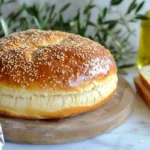
Muffuletta Bread: A Taste of Sicilian Tradition in Every Bite
- Total Time: PT2H
- Yield: 1 large round loaf (serves 6-8)
- Diet: Vegetarian
Description
Muffuletta bread is a traditional Sicilian-style round loaf with a golden crust and a soft, yet sturdy interior. Topped with sesame seeds, it boasts a rich, nutty aroma and a slightly chewy texture, making it perfect for hearty sandwiches like the famous New Orleans muffuletta sandwich.
Ingredients
For the Dough:
- 4 cups (500g) bread flour (or all-purpose flour)
- 1 ½ teaspoons salt
- 1 tablespoon sugar
- 2 teaspoons active dry yeast
- 1 cup (240ml) warm water (about 110°F/43°C)
- 3 tablespoons olive oil
For the Topping:
- 2 tablespoons sesame seeds
- 1 tablespoon olive oil (for brushing)
Instructions
Step 1: Activate the Yeast
- In a small bowl, combine warm water, sugar, and yeast. Stir gently and let sit for 5-10 minutes until foamy.
Step 2: Prepare the Dough
- In a large mixing bowl, whisk together the flour and salt.
- Make a well in the center and pour in the yeast mixture and olive oil.
- Mix until the dough starts to come together. Transfer to a floured surface and knead for 8-10 minutes until smooth and elastic. (If using a stand mixer, knead with a dough hook for about 5 minutes on medium speed.)
Step 3: First Rise
- Lightly grease a bowl with olive oil and place the dough inside. Cover with a clean towel and let it rise in a warm place for about 1-2 hours, or until doubled in size.
Step 4: Shape the Dough
- Punch down the dough and shape it into a round loaf.
- Place it on a parchment-lined baking sheet and press down slightly to flatten the top.
Step 5: Second Rise
- Cover and let the dough rise for another 30-40 minutes while preheating the oven to 375°F (190°C).
Step 6: Bake the Bread
- Brush the surface with olive oil and sprinkle sesame seeds evenly.
- Bake for 25-30 minutes, or until golden brown and the bread sounds hollow when tapped.
Step 7: Cooling and Serving
- Transfer to a wire rack and let cool before slicing. Enjoy as a sandwich base or with dips and spreads!
Notes
- Store at room temperature in an airtight container for up to 3 days.
- Freeze for up to 3 months by wrapping tightly in plastic wrap and storing in a freezer bag.
- Prep Time: PT1H30M
- Cook Time: PT30M
- Category: Bread, Baking
- Method: Oven
- Cuisine: Italian, New Orleans

